Ever since the fall of the Iron Curtain, the Czech Republic has evolved into one of Europe’s most popular travel destinations. To this end, the Czech Republic has fairy tale esque qualities. Castles, chateaus and fortresses seem to be everywhere you look.
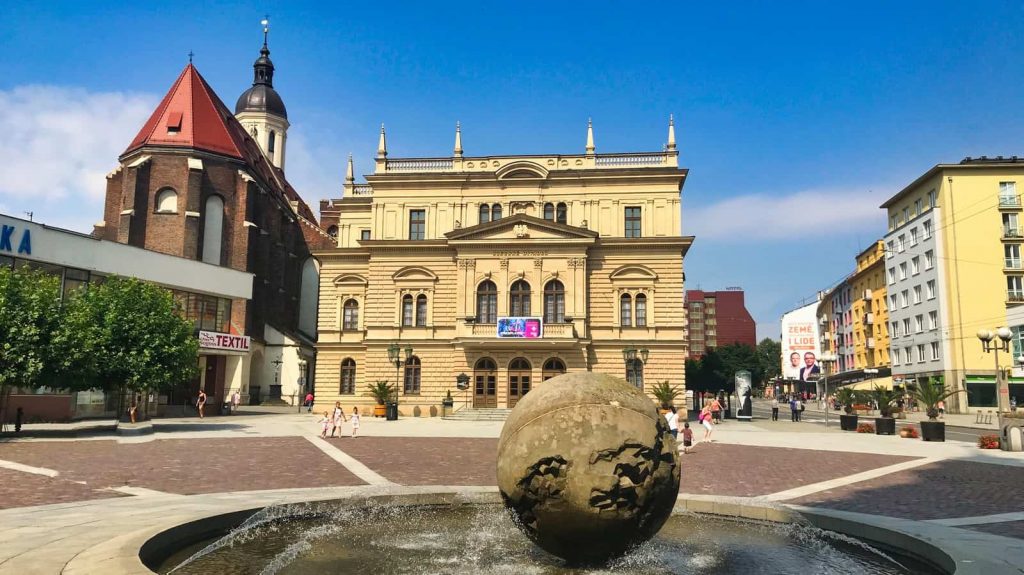
Everyone who visits the Czech Republic starts with Prague. Prague is the cultural center of the country and one of Europe’s most fascinating cities. Prague offers a wonderful medieval core of Gothic architecture, but it’s crowded with almost 8 million people visiting there each year. There is so much more to see in the Czech Republic than just Prague.
The Czech Republic is a country of contrasts. Chocked full of history yet the Czech Republic of today is also a forward-thinking nation. To get a more authentic view of the Czech Republic, we recommend visiting the exciting cities of Ostrava and the lovely Opava.
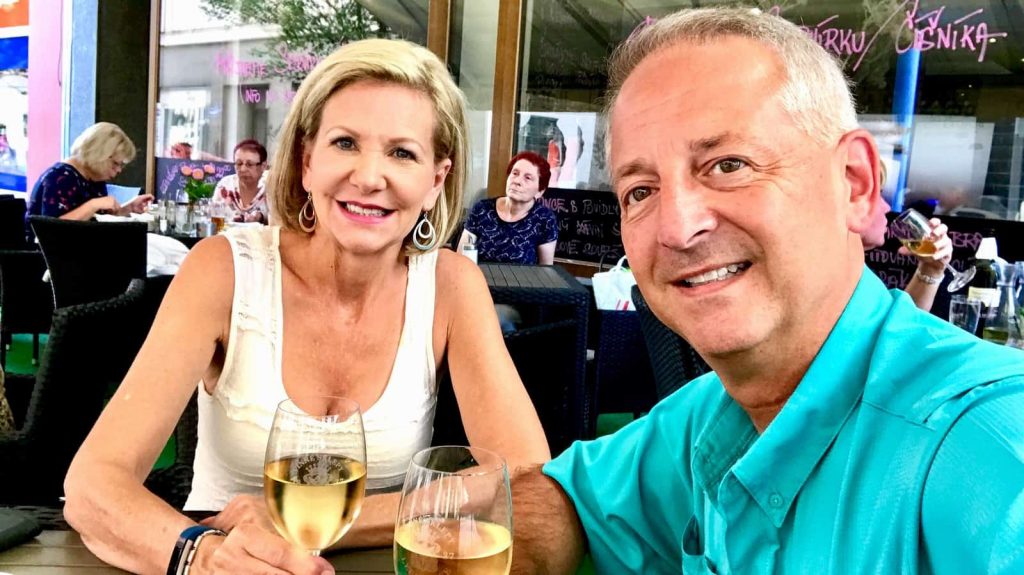
Ostrava, the Capital of Monrovia
Ostrava, located in the Moravian region of the Czech Republic is the country’s third largest city. Ostrava has a long history, but in the last century, Ostrava became a city no one wanted to visit. Known for its heavy industry focusing on coal mining and iron production, Ostrava was considered a dirty city. So much so, it was nicknamed the “black” city by locals because just walking around you would have black soot on your skin and clothes.
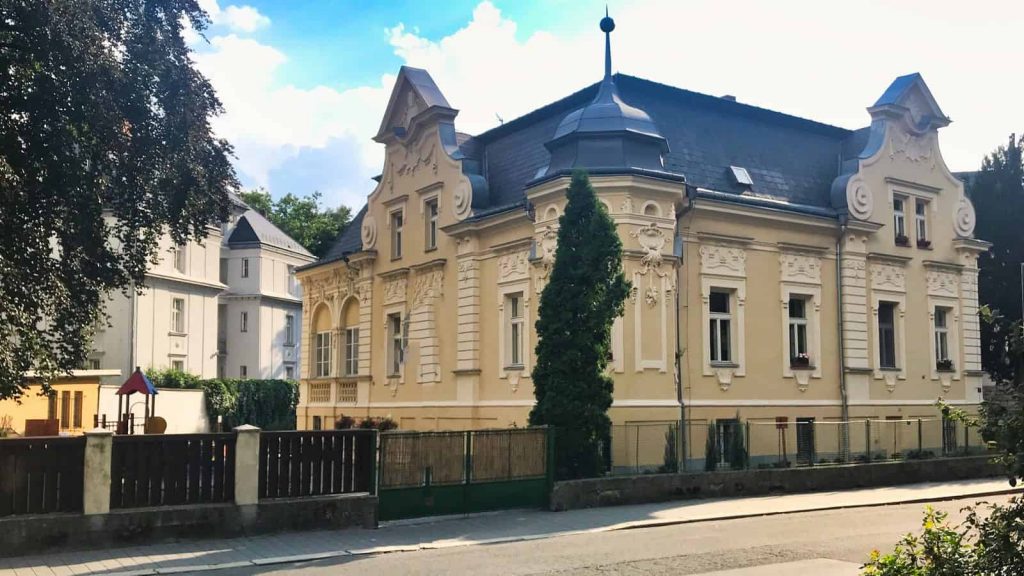
Thus, In 1994, five years after the fall of Communism, mining stopped in Ostrava. So, the city quickly set about to clean up its look and its reputation. The people of Ostrava took something old and made it new. Today Ostrava is attractive and vibrant. Even though the city has changed its vibe, it has not forgotten its coal mining past.
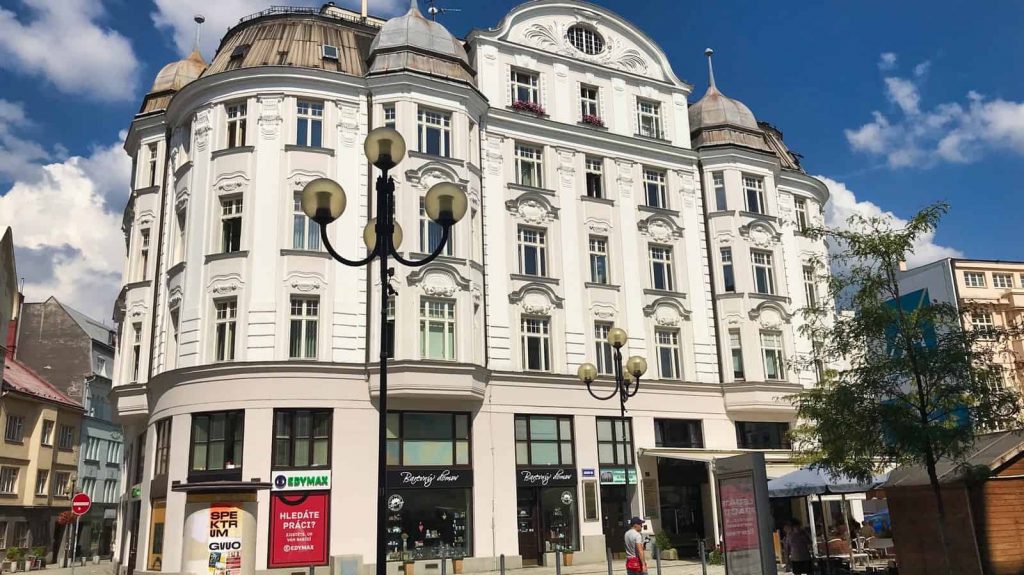
Lower Vítkovice area
The Lower Vítkovice area is a revitalized former steelworks and coal mining industrial complex in the heart of Ostrava city center. Given that, Ostrava converted this industrial complex into a multifunctional cultural auditorium complex known as the Gong Center. The auditorium was formerly a gas tank. The rusted blast furnaces and twisted metal factory is still part of the terrain.
Keith and I attended a Travel Bloggers conference at the Gong Center while we were traveling in the Czech Republic. As we stood inside the Gong Center, we could not imagine that we were inside a massive gas reservoir tank. At the same time, nothing about the external looks suggests that this industrial structure concealed a modern convention hall or exhibition space.
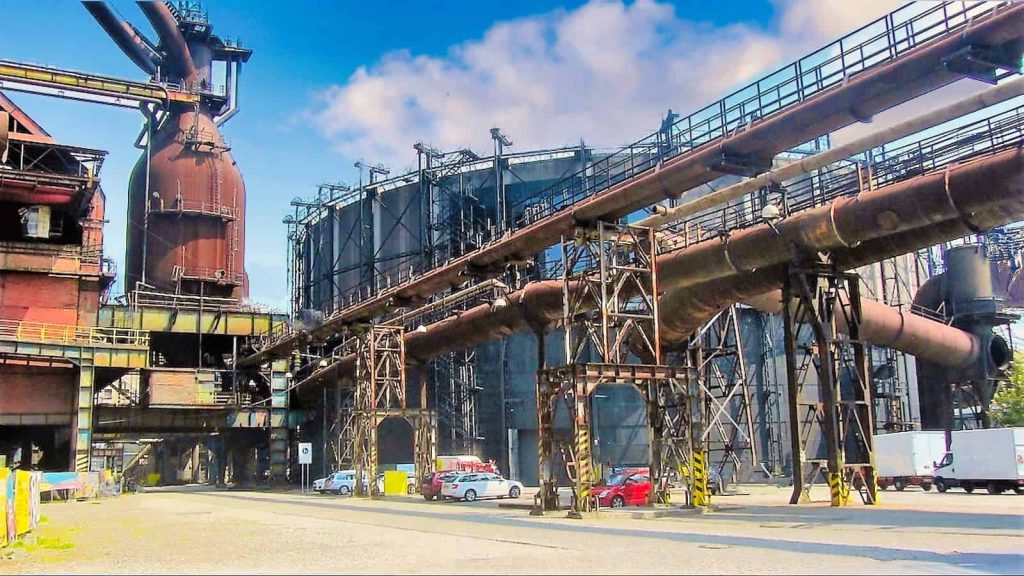
Bolt Tower
The most famous icon of Vitkovice is the Bolt Tower. Bolt Tower is an observation tower, but you can also take a guided tour of the blast furnace. So, on the tour, you will learn about the history of Vítkovice and the production of pig iron. Reservations are required so check the Bolt Tower site for directions.
A tour up the blast furnace not only offers an interesting insight into how an iron factory works but also impressive views of the entire complex.
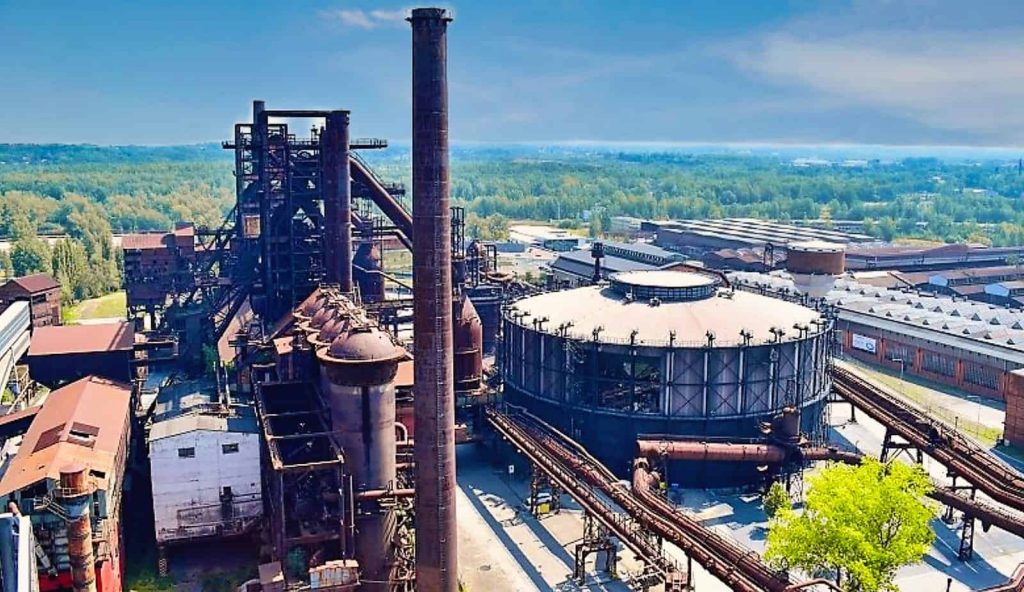
Getting Around Ostrava
We arrived in Ostrava via train from Poland. From there we took a taxi to our hotel, the Mercure. We chose the Mercure because it is less than ten minutes from the central train station and within walking distance of the cultural districts. For the next week that we were in Ostrava, we either walked or took the train system. Despite its size, Ostrava is a very easy place to get around. In addition, public transport is excellent, and it is well-connected to the rest of the Czech Republic or Europe via the train station.
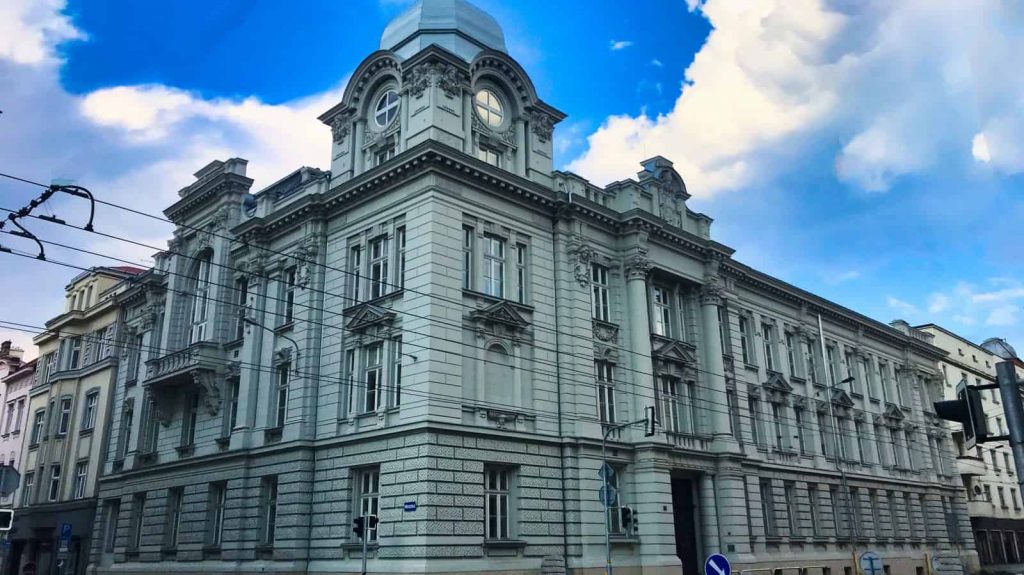
Street Art
In Ostrava is where you will find the largest street art piece in all of the Czech Republic. It is called the Madonna Ostravica. When you are in front of this piece of art, you will wonder what she is thinking about. Most important, the Madonna Ostravica was created by the famous American street artist Nils Westergard in 2016. He painted her during a weekend, on the façade of a crumbling building which used to be a shopping center.
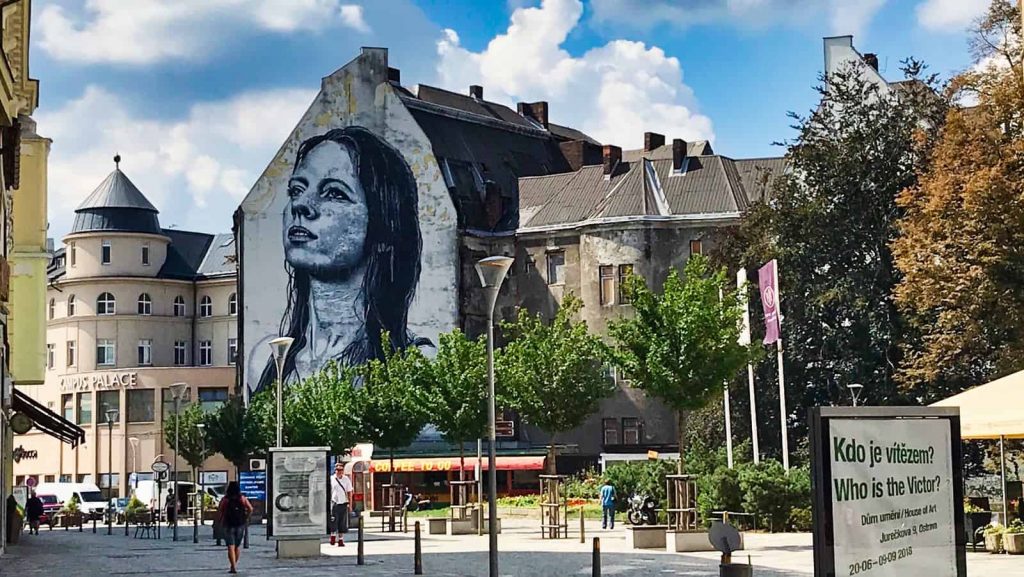
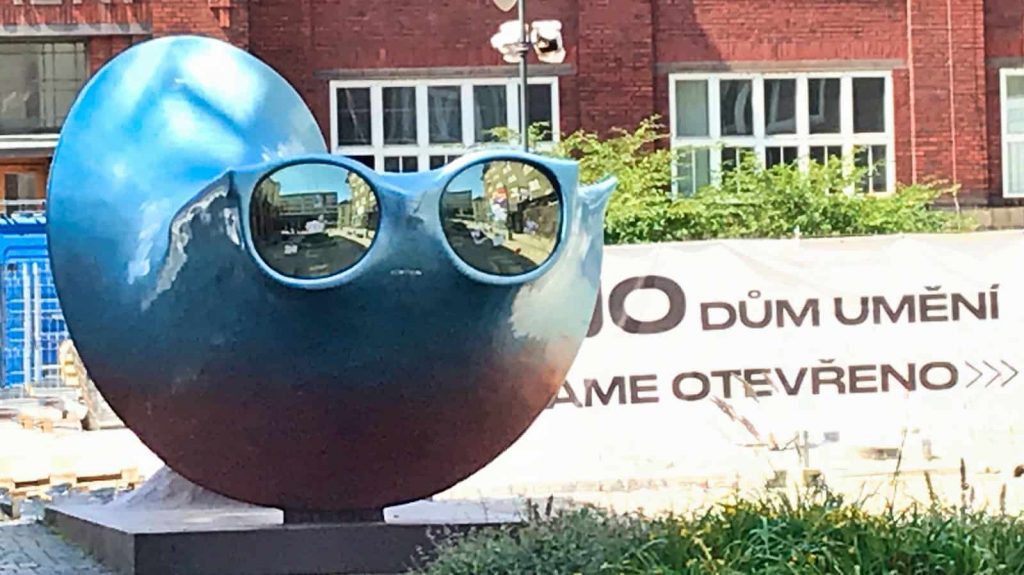
The Lively Masaryk Square or City Center
Ostrava is the third largest city in the Czech Republic and is close to the border of Slovakia and Poland. Also, in the Middle Ages, Masaryk Square, Ostrava’s center, was home to a marketplace. Equally Important, the oldest preserved building in the square is Stara Radnice or the Old Town Hall built in the sixteenth century. Presently, the Old Town Hall houses the Museum of Ostrava. The market square has a lively fountain in front of centuries-old Baroque buildings. Accordingly, the atmosphere is gorgeous, and a must-do activity in Ostrava.
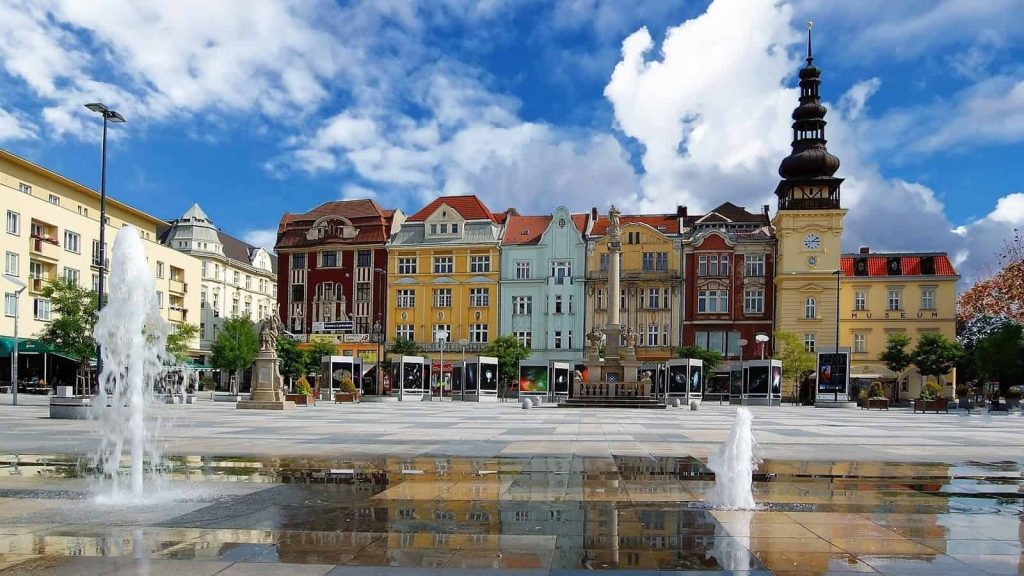
Ostrava City Hall
The Viewing Tower of the Ostrava City Hall is one of the city’s most popular tourist attractions. Without a doubt, you can see all of Ostrava, the nearby mountains, and even some of neighboring Poland. You can’t miss the viewing tower when looking at the Ostrava skyline. The tower is equipped with an illuminated clock, an elevator, and a lookout deck. Also, the Ostrava City Information Center, located directly beneath the tower, provides information about the city, in many languages. The tower is open every day, but I suggest you check Ostrava’s website for hours.
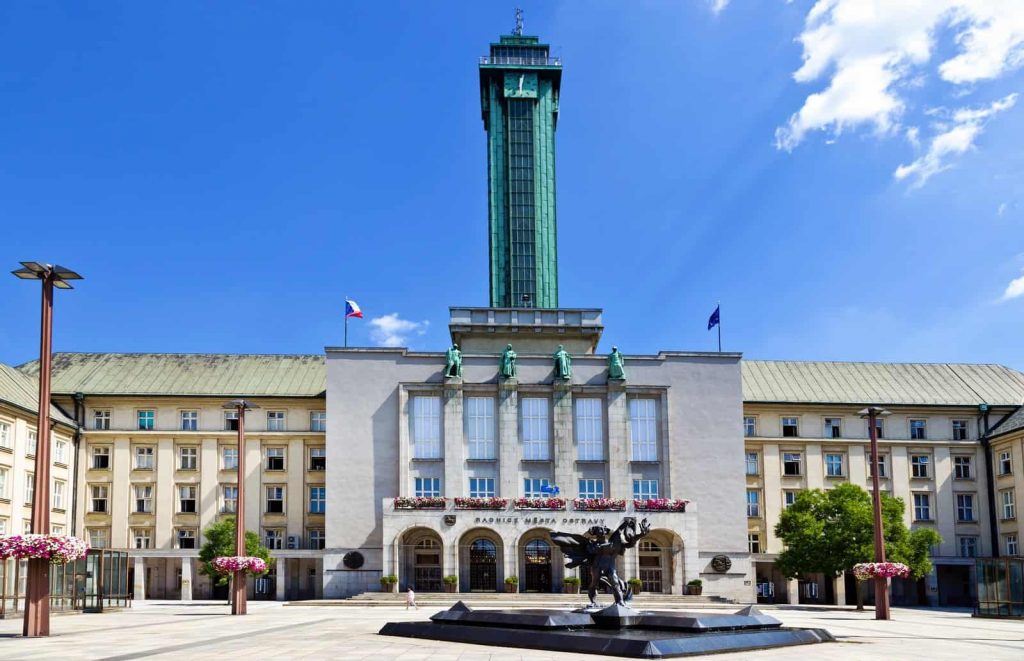
Ostrava Cathedral
The Cathedral of the Divine Saviour is a three-nave Neo-Renaissance basilica with a semi-circular apse and two towers. A point often overlooked, is the fact that the cathedral seats 4000 people and dates back to 1896. Important to realize, there are two organs in the cathedral and relics of Saint Hedwig of Silesia that lie at the altar. The cathedral is one of the many places in the historical city center worth a visit.
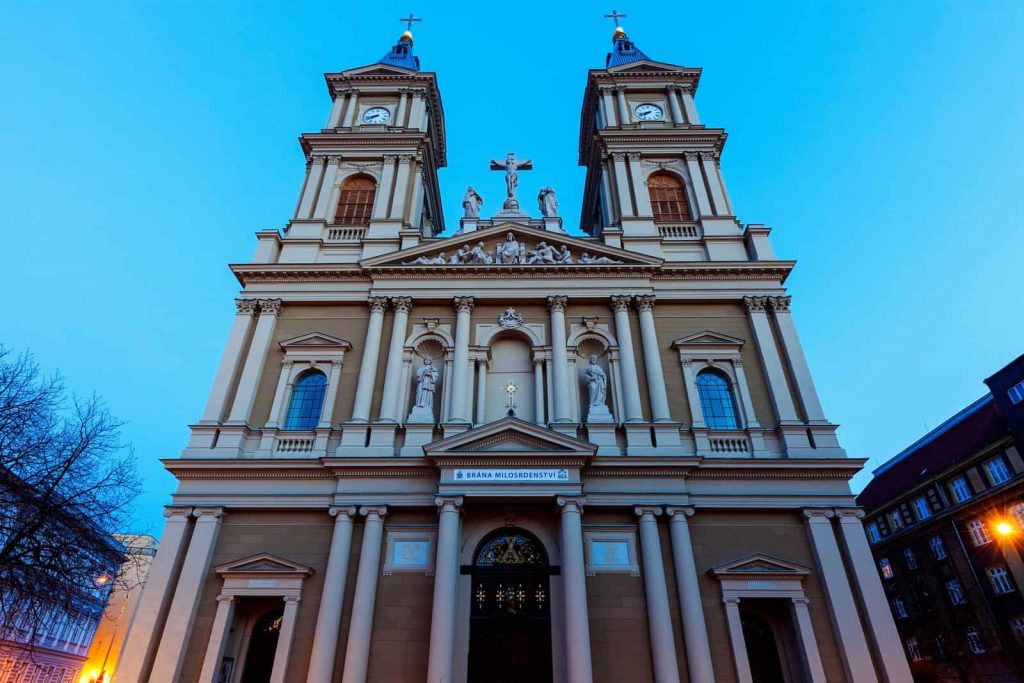
One interesting thing that this cathedral has is a changing stained glass window. It’s a digital window but when it’s not moving, you would never know it wasn’t real.
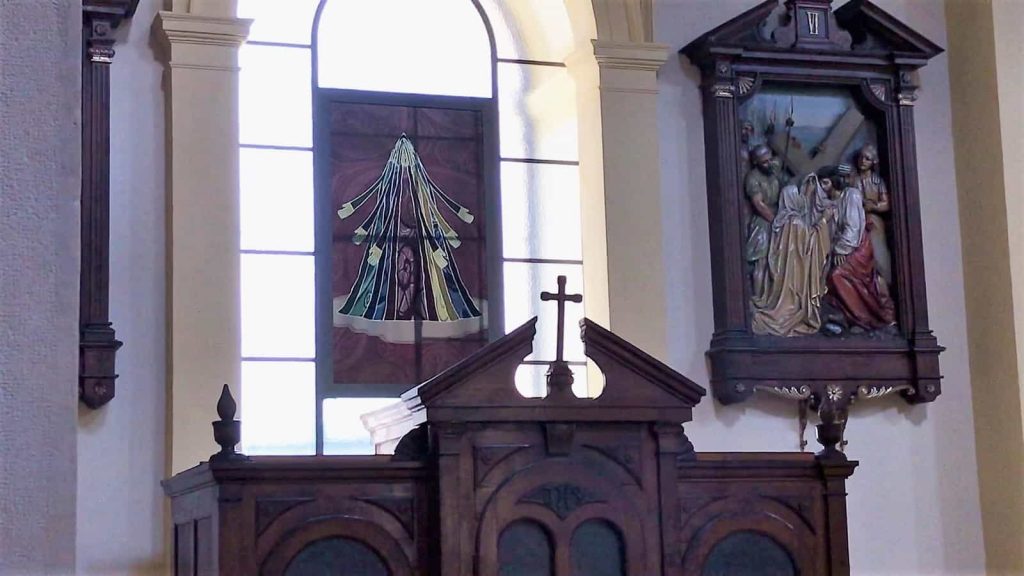
Opava
Take a full day to see Opava. Evidently, Opava is commonly called the White Pearl of Silesia. Given that, Opava endowed with a mixture of Gothic, Neo-Renaissance and modern architecture style is lovely. Opava is a small city of approximately 58,000 in the Czech Republic. Even so, it was the formal capital of Czech Silesia. Opava is a North Eastern town tucked away near the Polish border. Opava boasts some stunning old town European architecture but also has a lovely lake and charming eateries.
Opava’s Lower and Upper Squares
Today Opava has two main squares; the Upper (Horni) and Lower (Dolni) Squares. Thus, the main feature of the Lower Square is the baroque St. Vojtech’s Church. St. Vojtech’s Church built in the 17th century is the pearl of the city. Also in the Lower square, you will see lovely new buildings mixed with extremely well preserved old buildings.
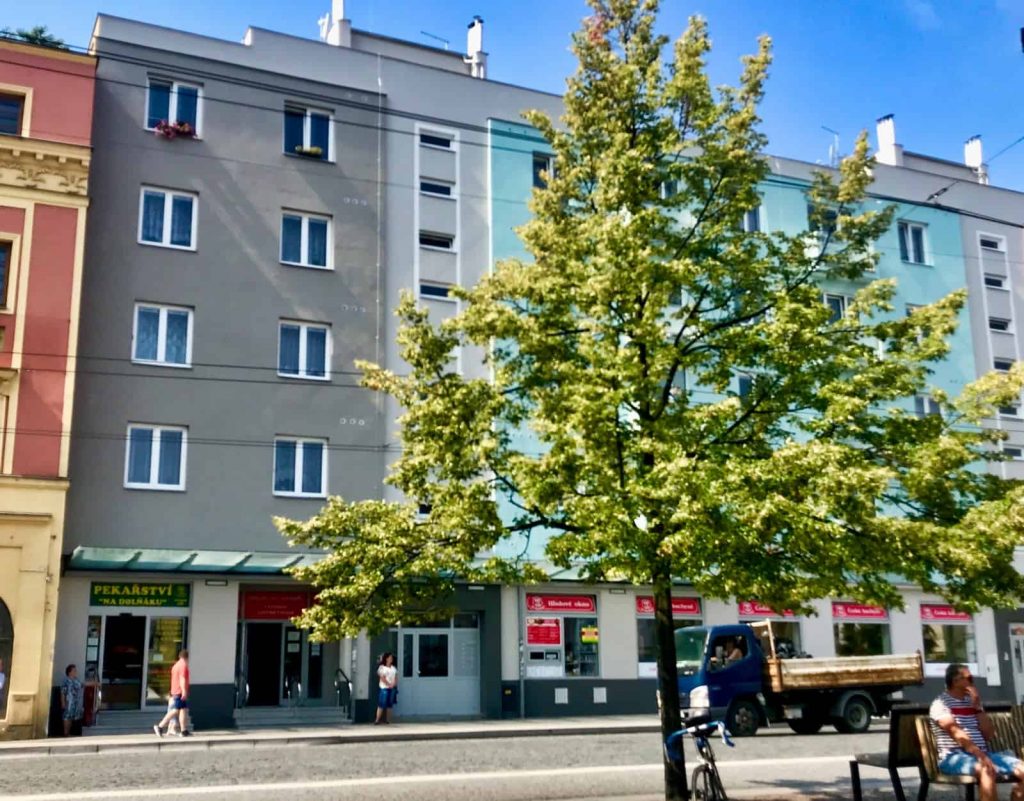
St. Vojtech’s Church serves as an important pilgrimage site where 4,000 masses are said each year. Just outside the church, you can admire the Baroque Marian Column which also dates back to the late 1600s.
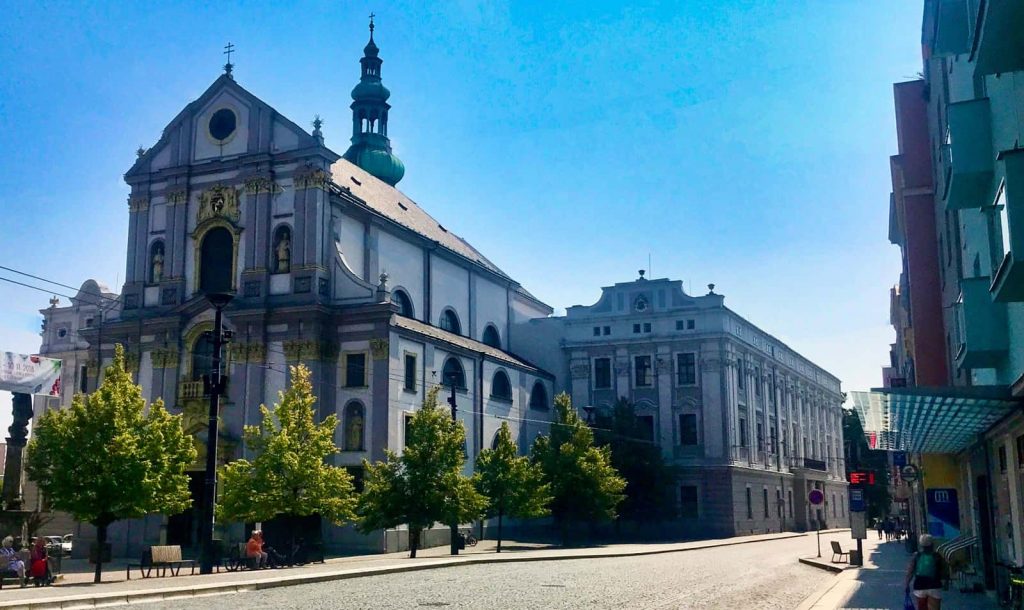
The main feature of the Upper Square is the town hall with its watchtower. You can climb the watchtower called
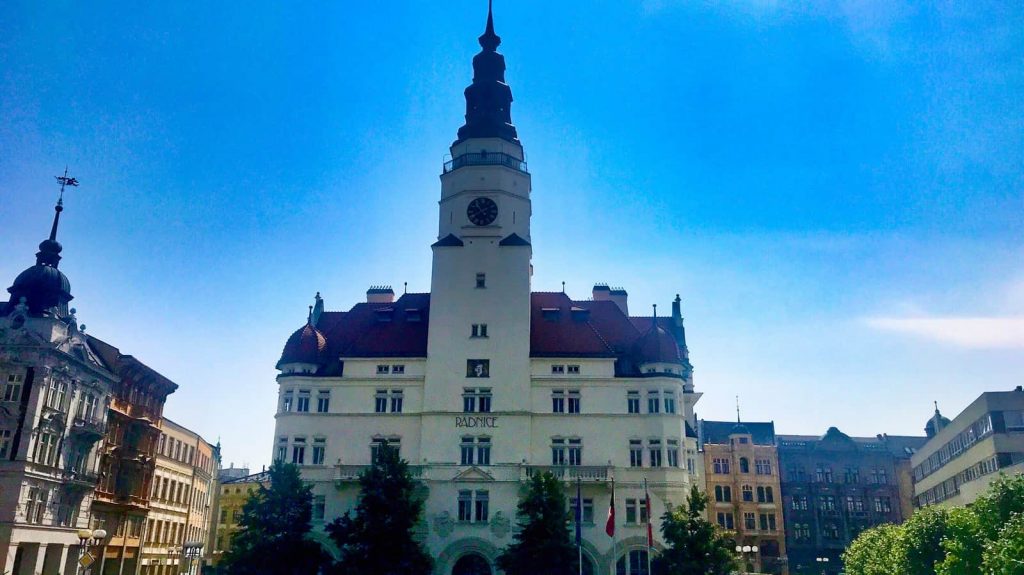
From the top of this watchtower, men would keep watch for invaders. Initially constructed between 1614 and 1618 the Renaissance tower sat on top of an older wooden tower. In the early 1900s, Art-Nouveau elements added to the tower completed its look. Visitors may go up to the watchtower at various times throughout the year. Also Inside the tower are permanent exhibitions of the history of the tower.
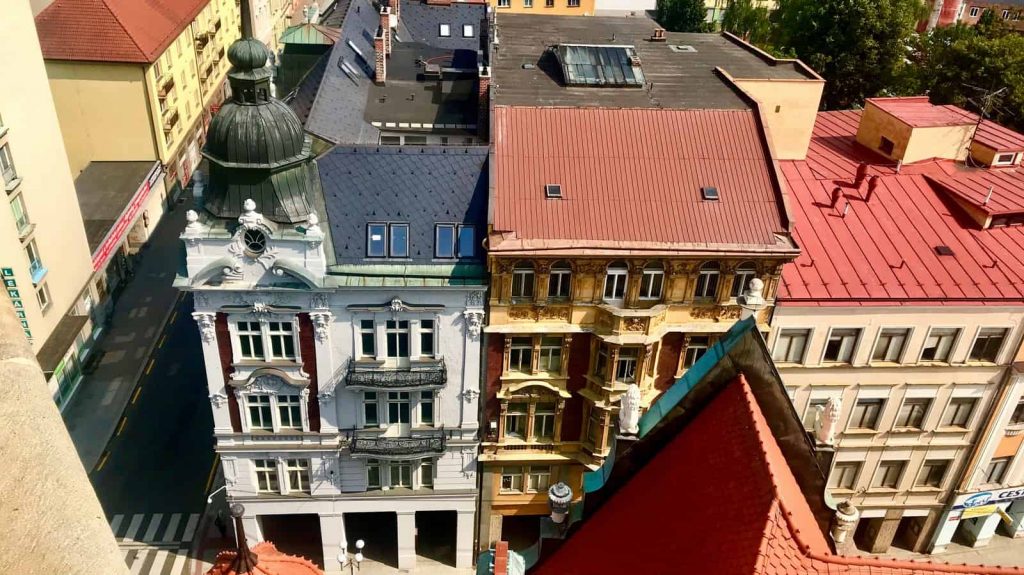
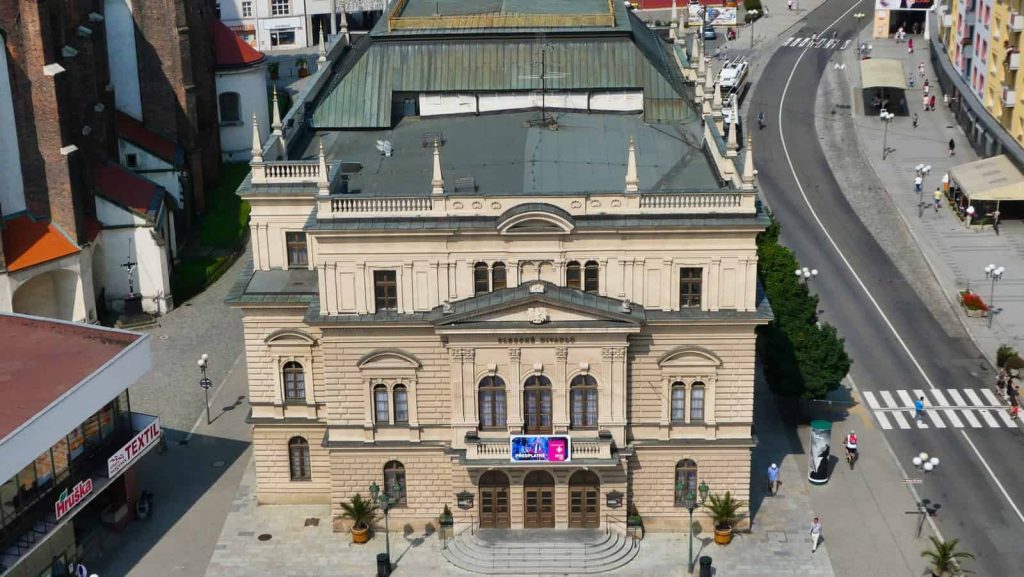
Cathedrals
Also important to Opava is the Our Lady of the Assumption Co-Cathedral built at the end of the 13th century by knights. The church is an example of North German Gothic brickwork. The interior of Our Lady was renovated in Baroque style after a fire in the late 1600s. Presently, the church is a national monument.
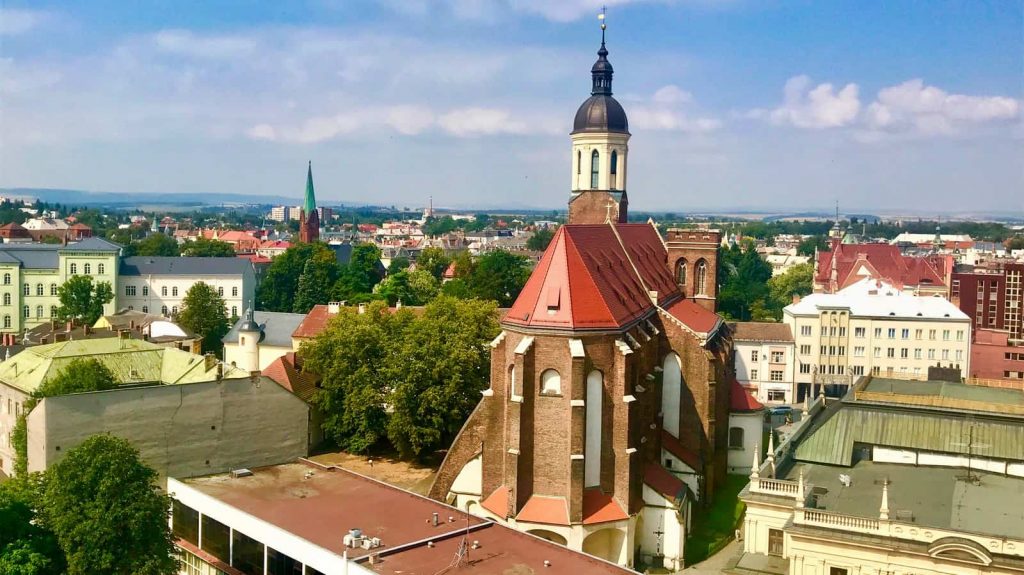
The lovely Masarykova Street contains the palaces of noblemen. The Silesian Theatre is another important landmark building for the town.
Silver Lake Area
Consequently, after touring the historical center of Opava, we suggest heading towards the Stribrne Jezero known as Silver Lake. At the lake, you can swim, have drinks or dine on snack food. In fact, the beer at this park is cheaper than the bottled water.
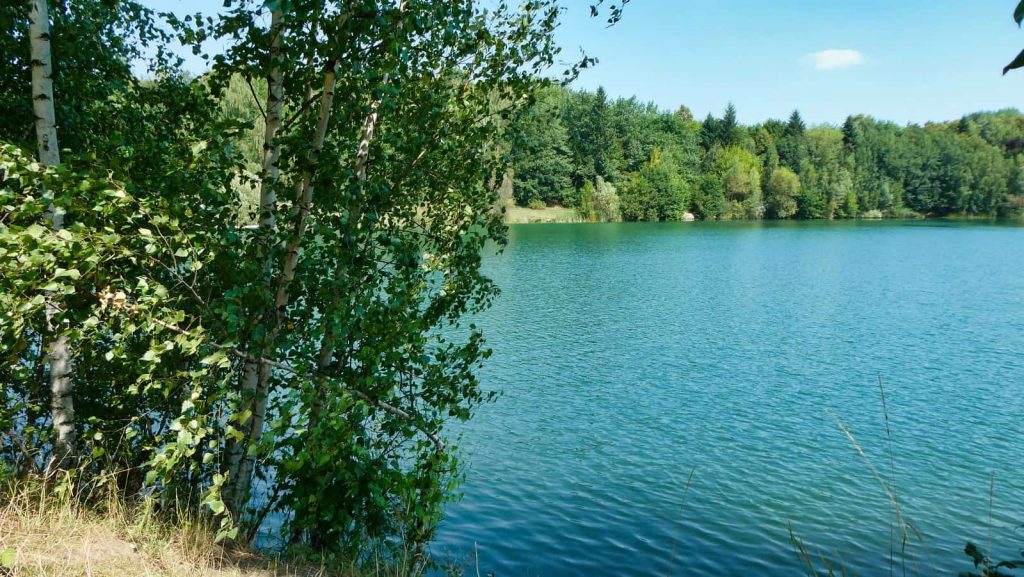
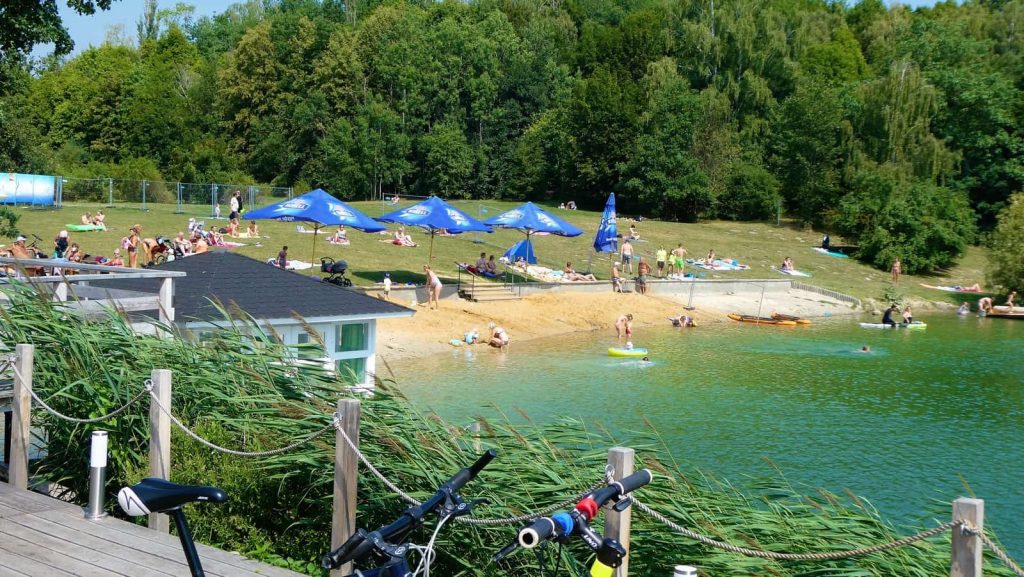
As part of our visit, Keith and I decided to play a game Disc Golf. Undoubtedly, the goal of the game is to try and get the disk into a chain basket hole. If no player makes it in the basket, then the person closet to the basket scores the point. Likewise, there were probably six of us playing, and Keith won. It’s a fun outdoor summer game.
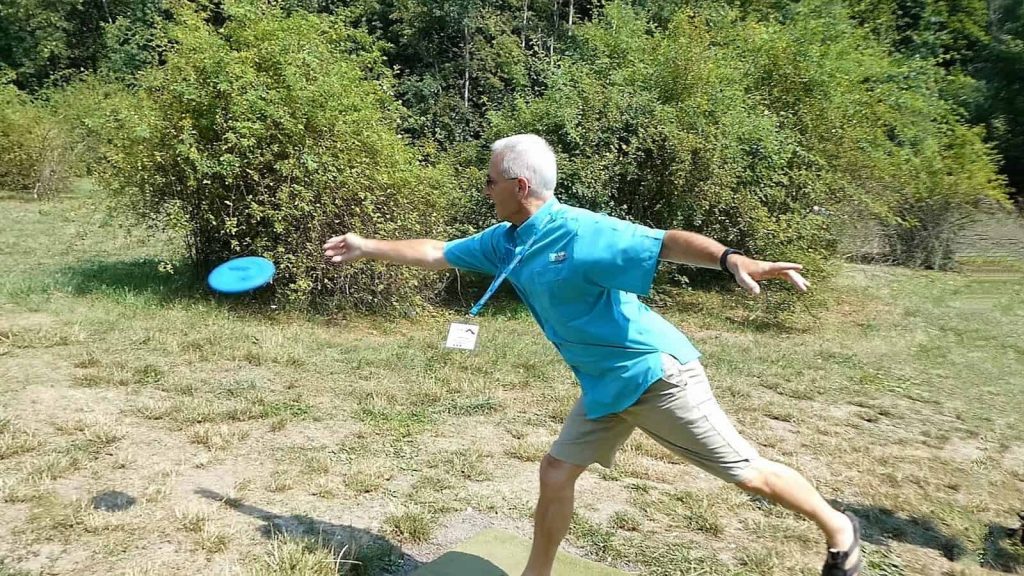
Lunch at Restaurace a Vinarna U Pfemka
Finally, after our fun at Silver Lake, we made our way to a Czech restaurant for lunch; we had worked up an appetite. To that end, we had a five-course lunch at U Pfemka. At U Pfemka, we experienced traditional dishes from the three regions of the Czech Republic; Bohemia, Monrovia, and Silesia. The head professor of gastronomy at the local university gave us a lesson on Czech food. Thus, we learned that Czech gastronomy was influenced heavily by the fact that it was part of the Austro-Hungarian Empire. In addition, the neighboring countries of Germany, Poland, Austria, and Slovakia influence Czech food.
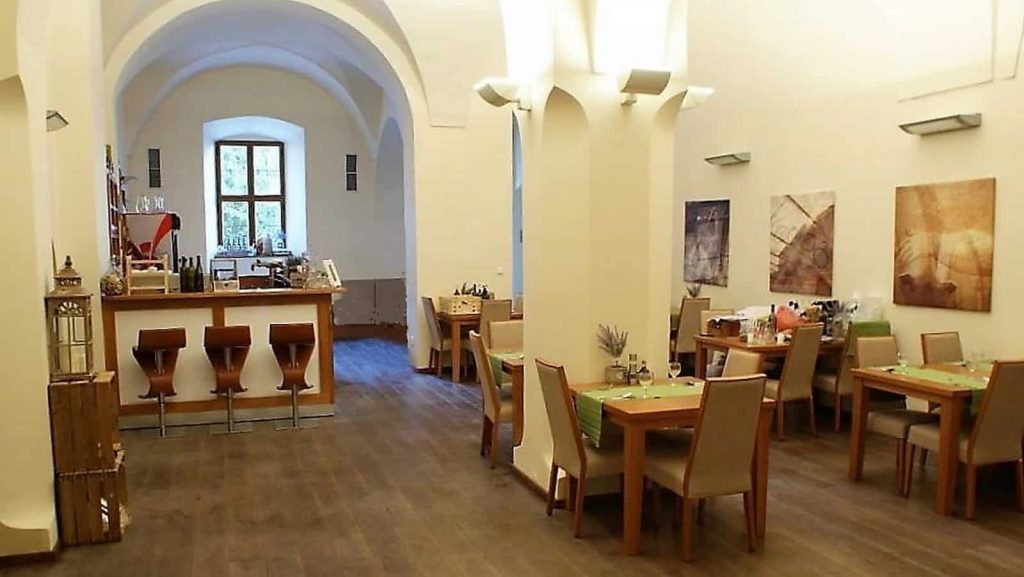
Five-course Meal
To begin with, our five-course lunch consisted of an appetizer of rolled ham and horseradish cream and an aperitif of Becherovka liqueur. We did not know but the most common side served with Czech meals are potatoes baked with cottage cheese and herbs. Our second course was Zander, a fish, with a side of the potatoes mentioned above. Our main course was smoked pork in an apricot sauce with potato dumplings. The next course was a local cheese with cranberry sauce. Additionally, each course was paired with a Czech wine. For dessert, we had semolina flummery, a sweet, soft dessert pudding, covered in a fresh raspberry sauce. Then we finished the lunch off with some Turkish coffee. Between the amazing education on the culture and food of the Czech Republic and tasting the food and wine, this was an awesome experience. Without reservation, everything was delicious.
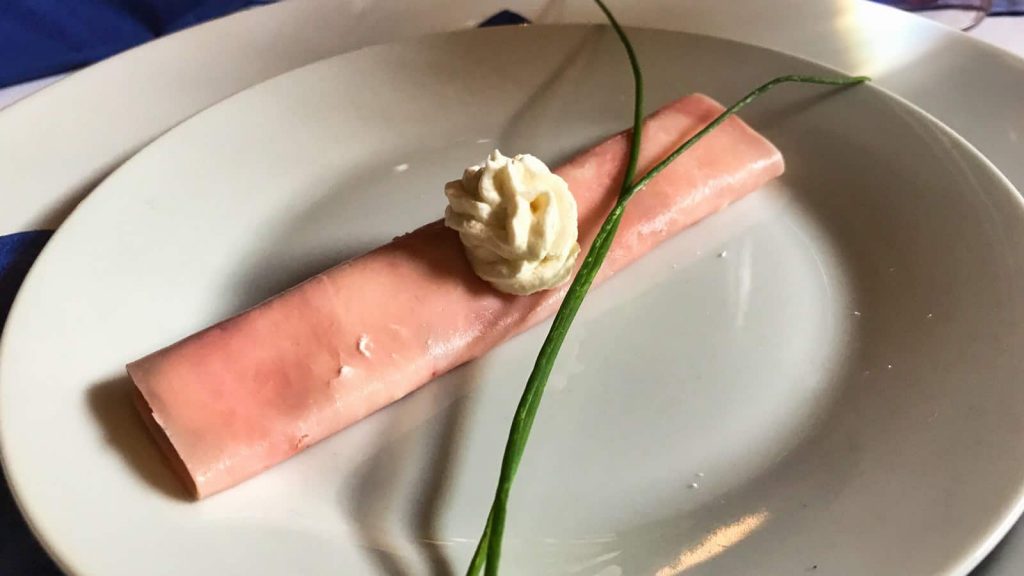
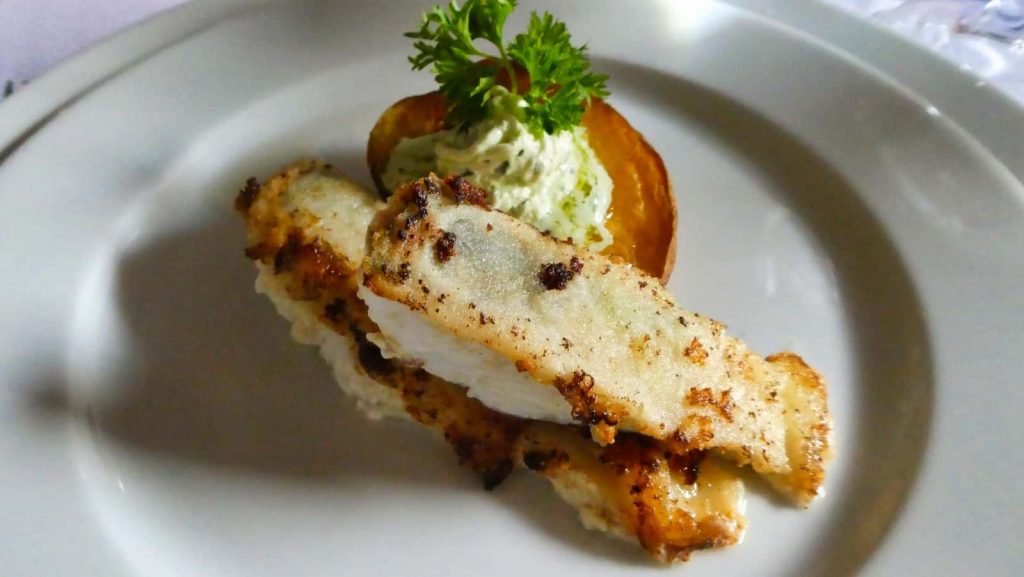
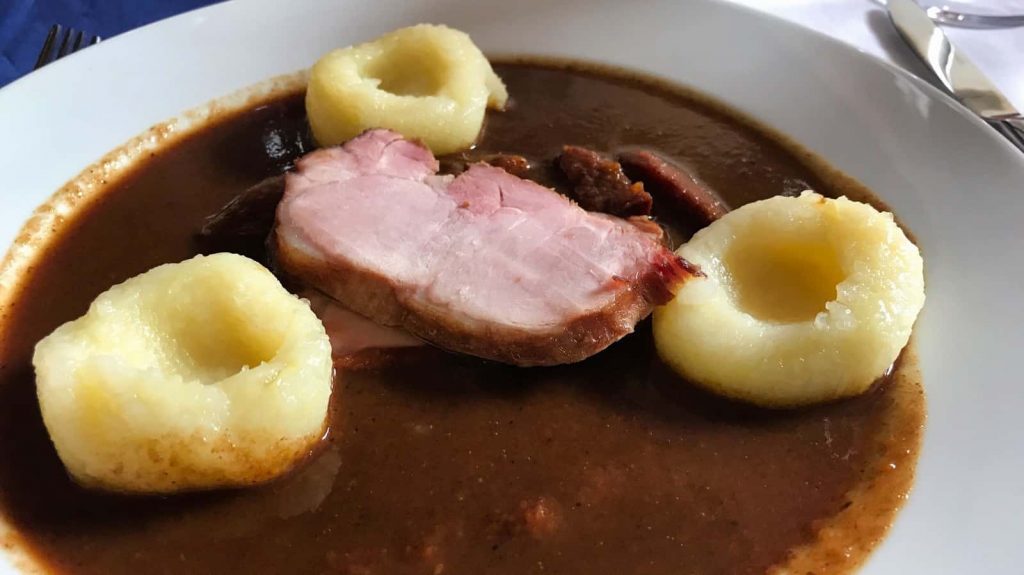
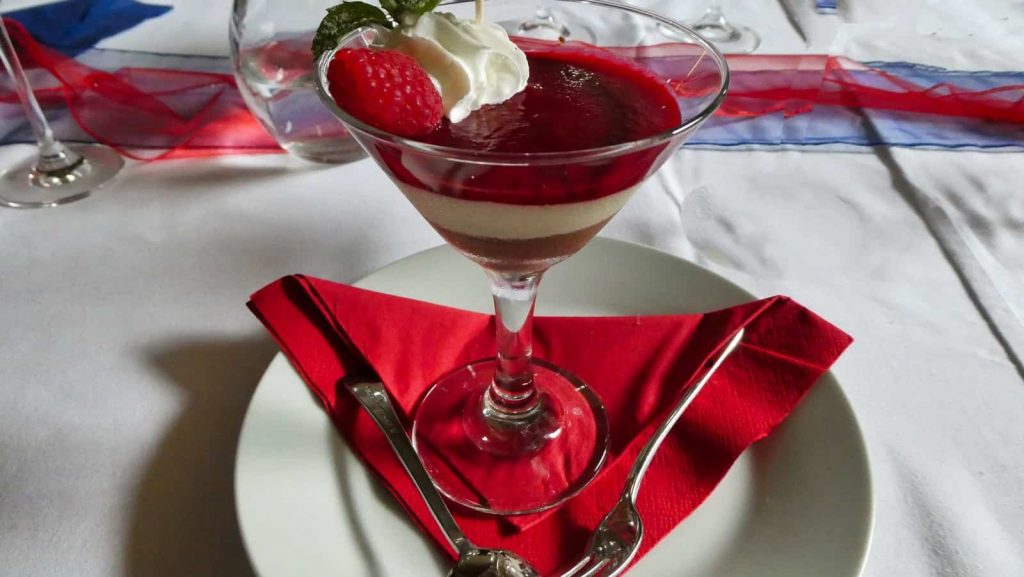
Semolina flummery, a sweet, soft dessert pudding
Afterwards, Keith and I tried Turkish coffee for the first time at this lunch. Turkish coffee made by bringing powdered coffee, water, and some sugar to a boil is smooth. The coffee is removed from the heat as soon as the mixture begins to froth. The grounds are left in the coffee when served.
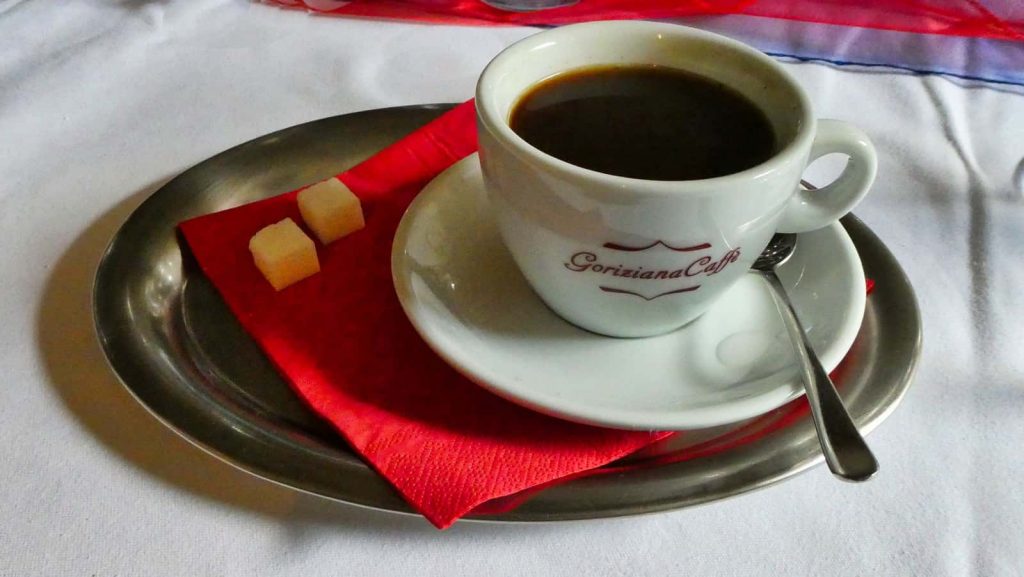
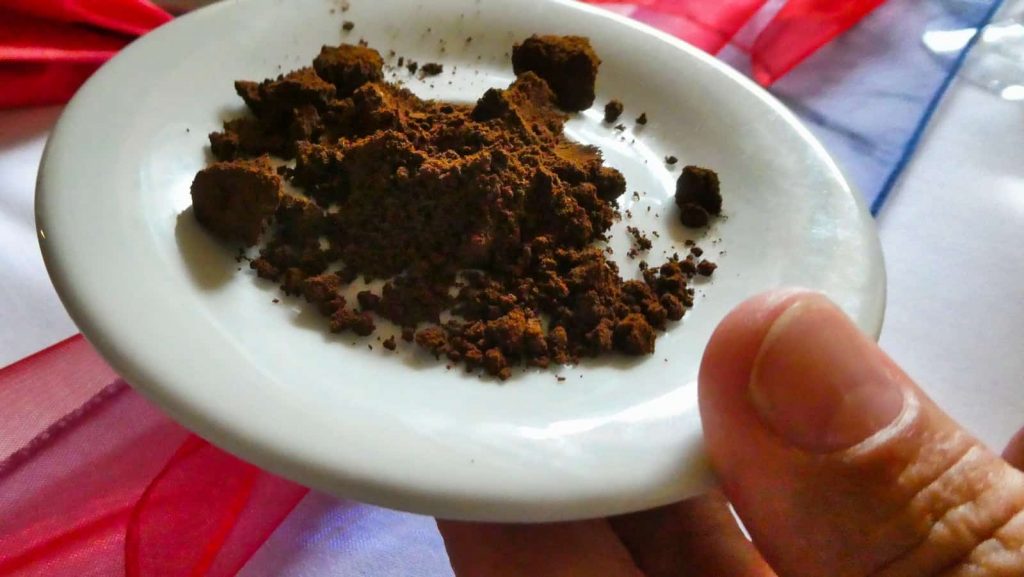
What Czech Republic People Drink
The first thing that you must know is that the Czech people like to take their time eating: they enjoy the peace of eating. So, along with their meal, most Czech’s will enjoy beer, wine or sometimes spirits. In the southern part of Monrovia, wine is prevalent. In the northern part of the Czech Republic, they like to drink liquor or spirits. But, the vast majority of the Czech Republic are beer drinkers. In fact, the country that drinks the most beer in the world per capita is the Czech Republic.
Church of the Holy Spirit
After lunch, I highly recommend visiting the Gothic-style Church of the Holy Spirit. Up to the present time, Archaeologists are working to discover the contents of the Crypt beneath the church. On a side note, pun intended, Beethoven attended a concert of his Mass in C Major at this Church. Certainly disappointed with how the conductor was presenting his work that he lept up and took over conducting!
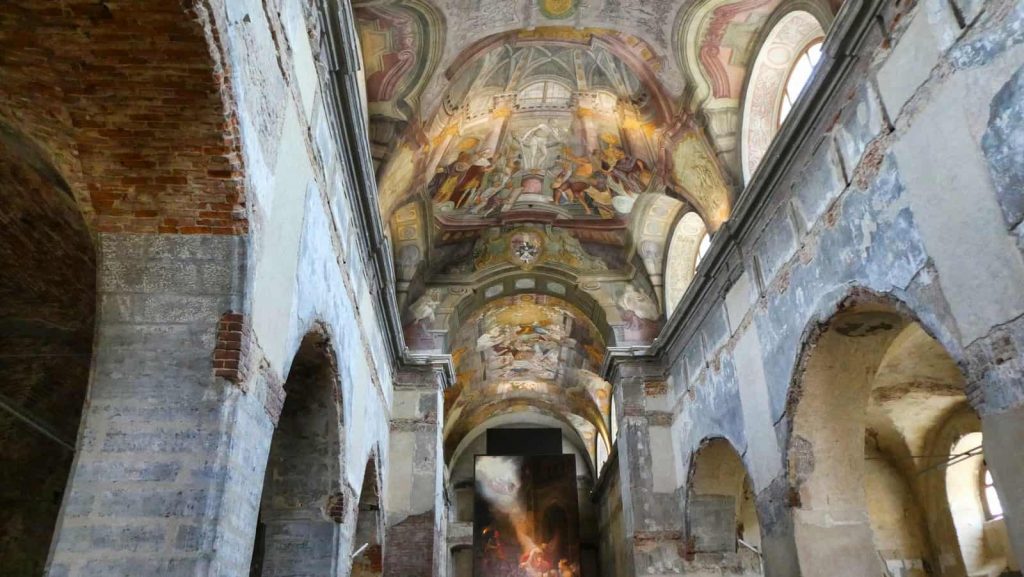
The Fairytale Hradec nad Moravicí Chateau
Not far from Opava is the charming little town of Hradec nad Moravicí. So to complete a wonderful day visit to the Opava area, we suggest a visit to the gorgeous Hradec nad Moravicí fortress and chateau. Actually, it’s two chateaus in one. Accordingly, the white Empire-style one is guarded by the fortress of its red neo-Gothic partner. A fairy tale sight. Originally Hradec nad Moravicí was a Renaissance country house built in the late 16th century. Then, at the beginning of the 19th century, it was rebuilt in Neo-classical style. This medieval fortress and Chateau sits on a small hill overlooking a beautiful pond. The chateau grounds are vast and beautiful.
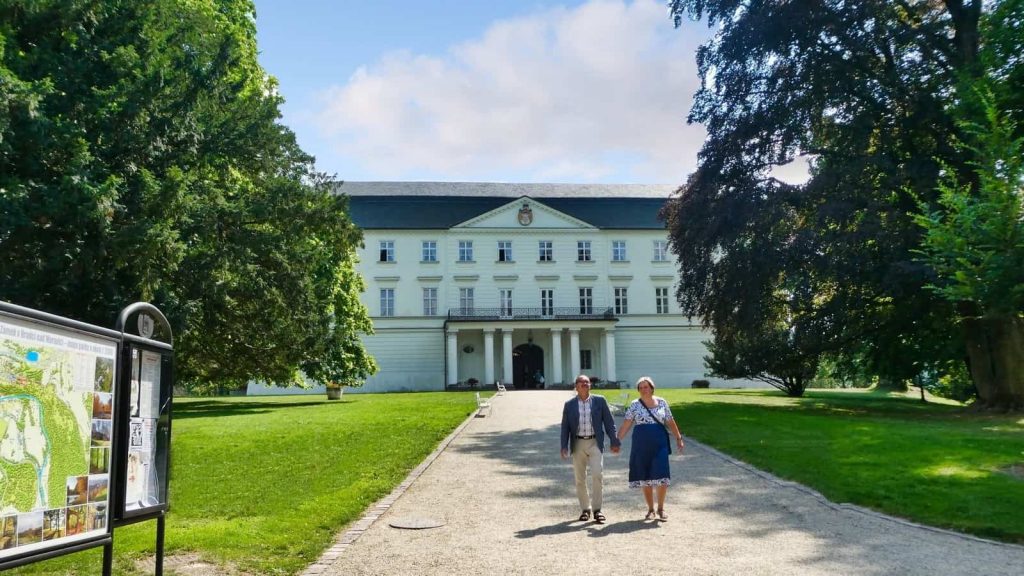
The white chateau, the oldest part of the chateau compound, sits on the same piece of land as an 11th-century castle once stood. Before that, an 8th century Slavonic fort stood on the same spot. The Renaissance chateau and lovely gardens are from the late 16th century. A fire demanded another renovation in the late 1700s giving the chateau its present-day look.
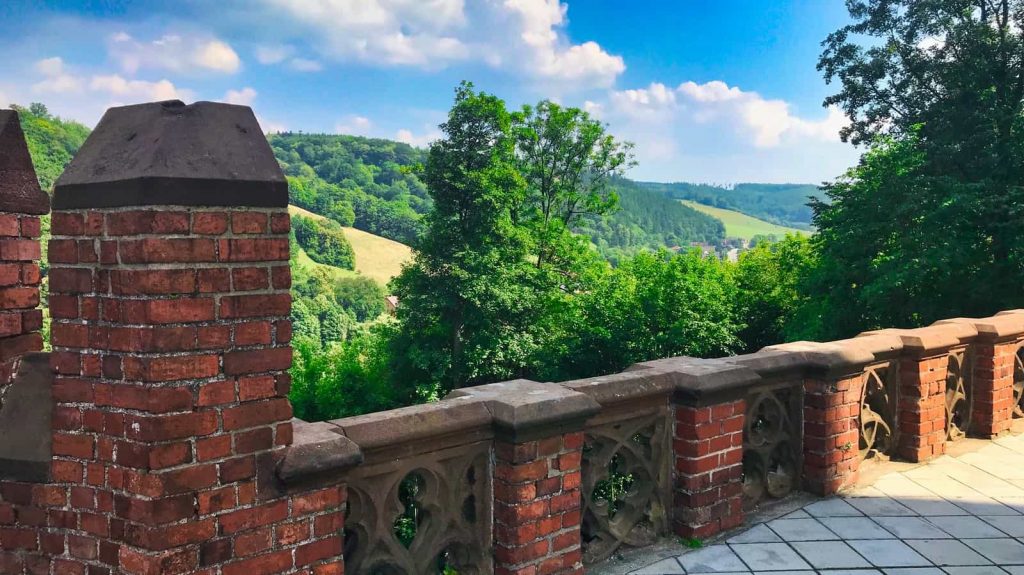
Presently, the younger fairytale esque Red Chateau built in the late 1800s serves as a hotel and restaurant. Inspiration for the neo-gothic design came from the castles of Germany. To clarify, the White Tower became part of the chateau complex at roughly the same time.
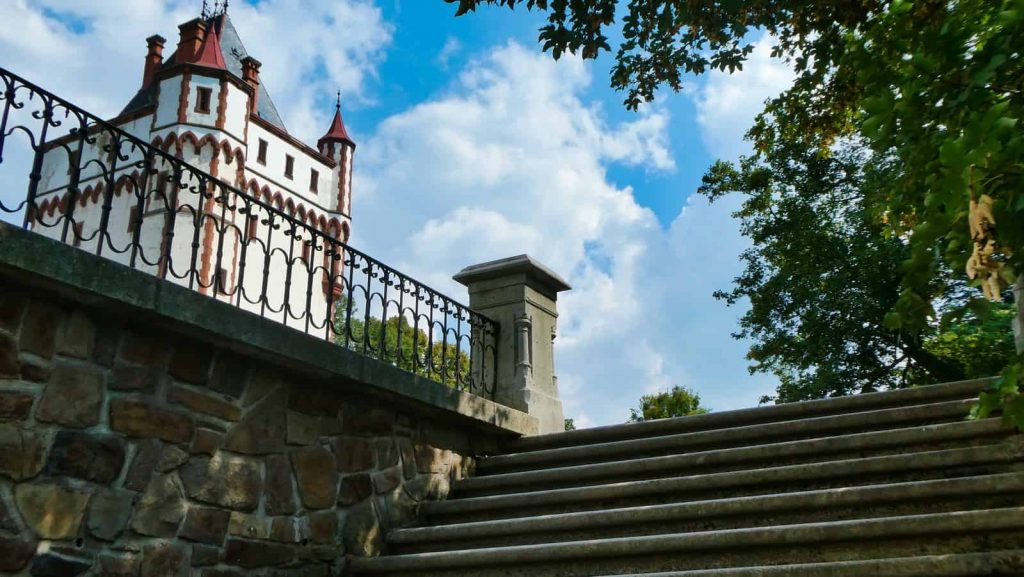
Six Generations of Lichnovsky’s Gave the Chateau its Personality
In the 18th century, the Lichnovsky family bought the home. What’s more, the Lichnovosky’s were patrons of the arts; Beethoven, Liszt, and other regularly visited the chateau. Also, prominent painters and authors were also guests of the chateau.
The collection of antiques on display at the Chateau came from six generations of Lichnovsky’s. Thereupon, you can see the different artistic tastes.
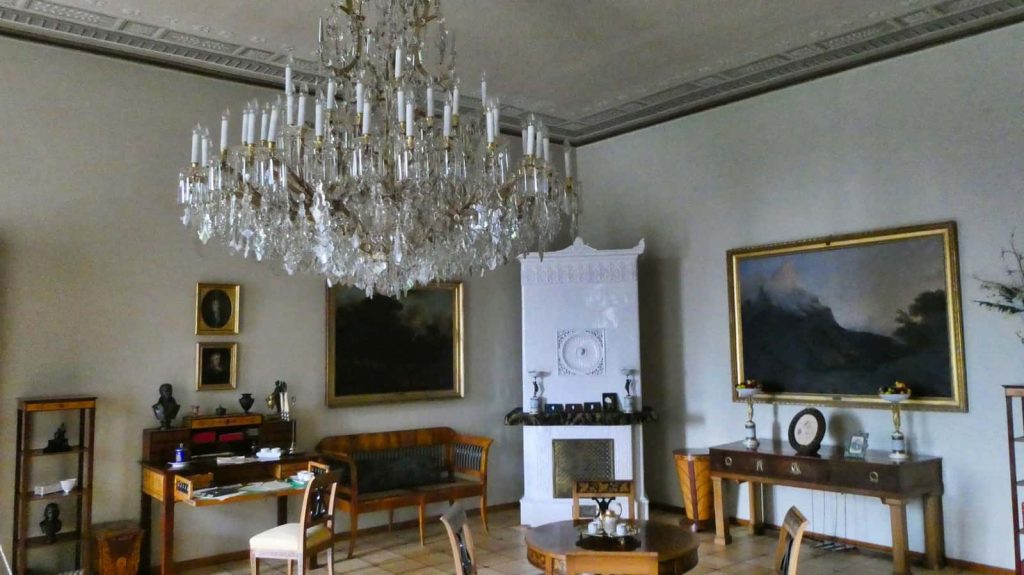
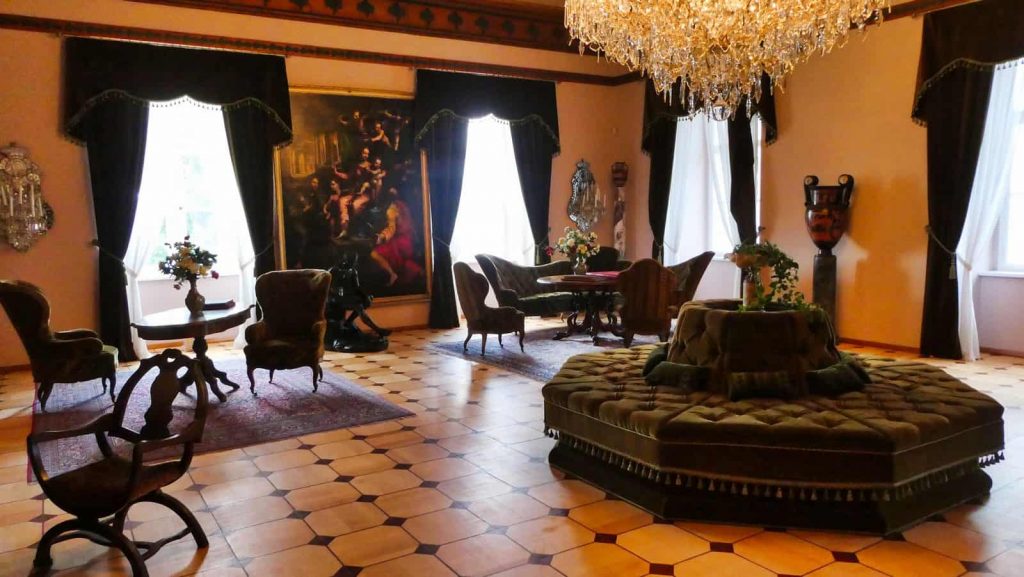
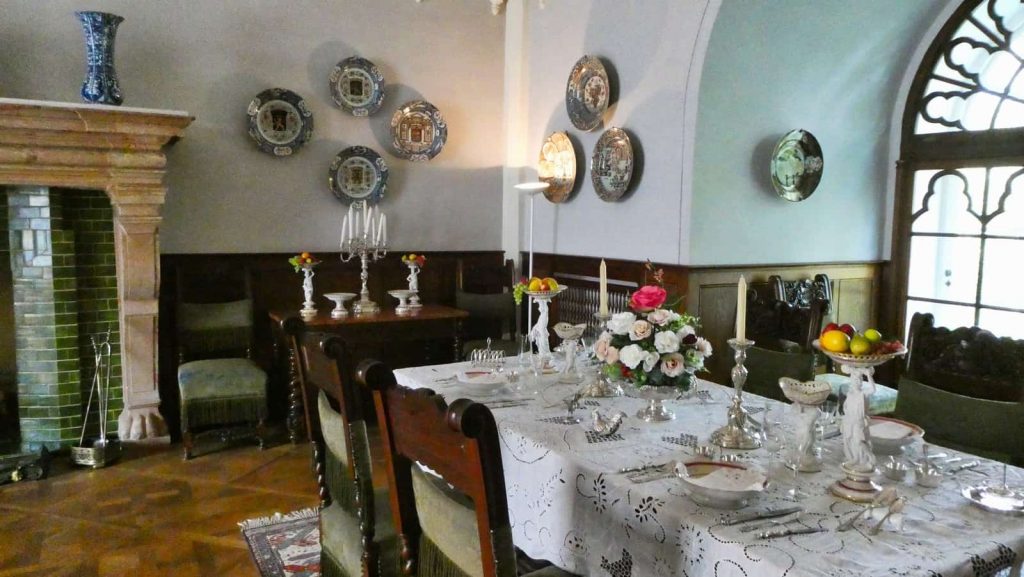
Similar to the Karolyi Chateau in Hungary the Hradec nad Moravicí chateau hosts a Music Competition for young pianists and violinists called Beethoven’s Hradec in June.
When visiting, allow time to walk the lovely, picturesque grounds. Sitting at the top of a hill the views from the chateau of the grounds and valley are wonderful. But, there is more to see and discover by walking the grounds.
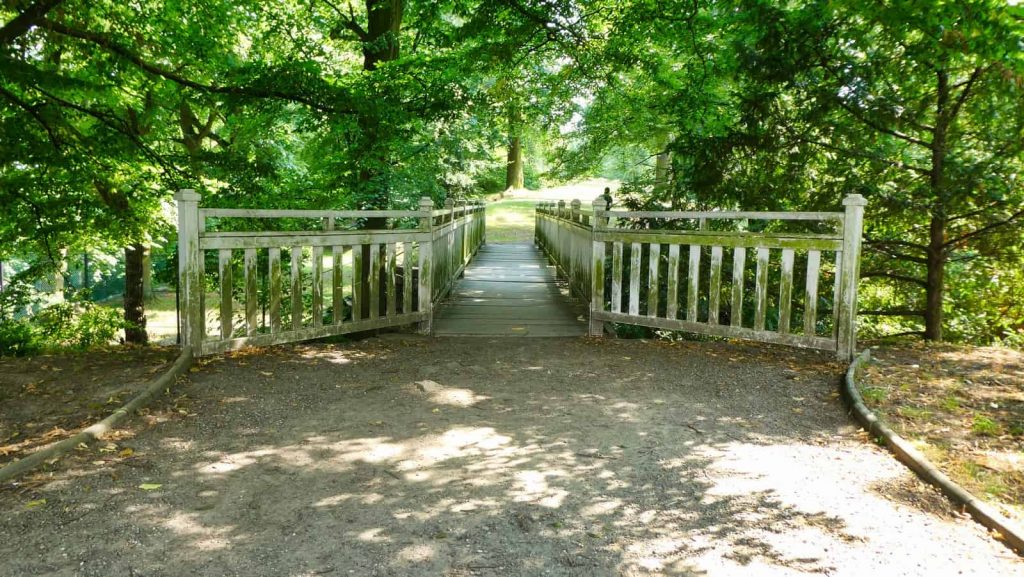
Affectionately Czechia
Not surprisingly, the Czech Republic affectionately called Czechia is a romantic country filled with castles, wine, and great beer. Once part of the Roman Empire, presently the Czech Republic includes the historical territories of Bohemia, Moravia, and Czech Silesia. Furthermore, if all you see on your visit to the Czech Republic is Prague, you are missing a lot. Ostrava and Opava in the northeast portion of the Czech Republic will give you a more complete feel for the country.
QUICK ANSWERS
Ostrava and Opava are an easy 3-hour train ride from Prague and offer much to see and do.
To read more about our Czech Republic adventures, take a look at Czech Spa Towns
Or, how about a 2-hour drive and visit the country next door Krakow Poland.
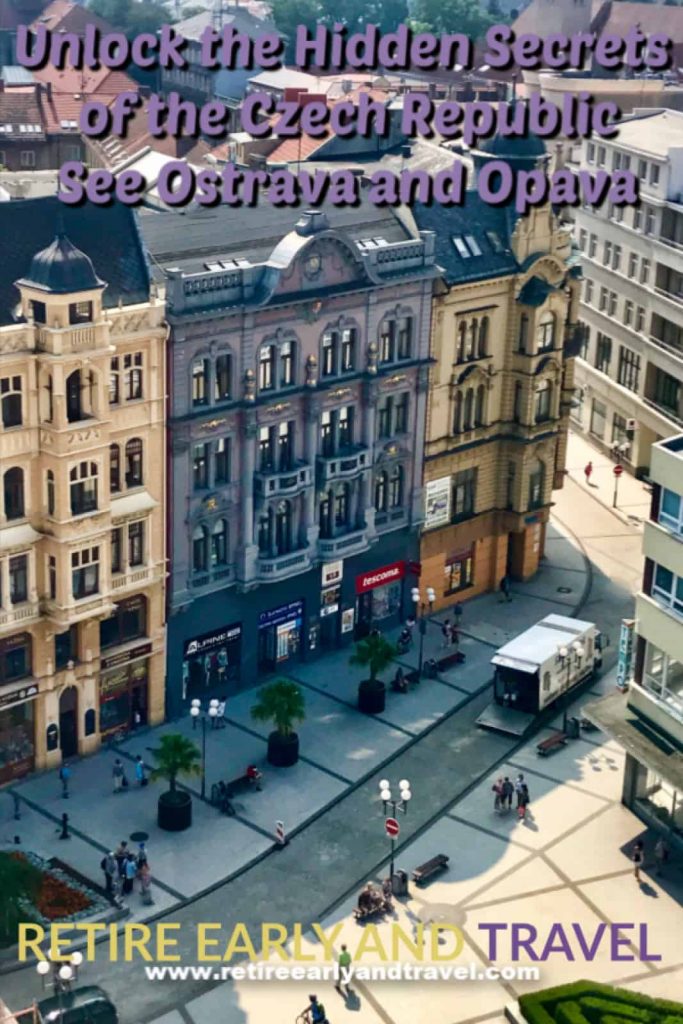
I read your blog. It is amazing. It describes tourism and its definition of real beauty. Your blog is Real and Beautiful.
I have a related blog journey.
Thanks Akash. I’m happy you like our blog.
Nice post! Thanks for sharing!
Thanks Mary. You’re welcome!
Good post. I searched for this topic. Finally I got the information in this blog. Thanks for posting such a nice article.
Thank you, we’re happy you found the information you needed.
I read your blog. It is amazing. It describes tourism and its definition of real beauty. Your blog is Real and Beautiful. and good work
thanks
Good info. Really nice information shared. Thanks for sharing the important points with us. – best shirdi tour package from chennai
Awesome Blog! It’s a great spot to find new information. Thank you so much for this wonderful article.
Thank you Shirdi. I’m glad you like our website.
It’s a great spot to find new information. Here we all can learn a lot of useful things. Thank you so much for this wonderful article. – best shirdi tour package from chennai
I come across very few articles as beautiful as this one, I really enjoyed your article and also liked your website too. Thanks for sharing such a great piece of information.
You’re welcome Vasant. Thanks for visiting.
Such a great post!! And it really makes me wonder why I still haven’t been to the Czech Republic yet! I mean, it’s not that far from our home-base in Austria..
Really have to explore my home-continent a bit more, I have the impression that Americans know more about it than I do 😀
Thanks for sharing! Loved reading it!
Cynthia
That’s funny Cynthia. We say the same about the United States sometimes. So much to see that is nearby. BTW… we loved Austria.